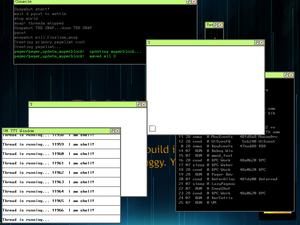Phantom OS: Difference between revisions
mNo edit summary |
Added tags |
||
| Line 1: | Line 1: | ||
{{copypaste|date=July 2011}} |
|||
{{primarysources|date=July 2011}} |
|||
{{New unreviewed article|source=ArticleWizard|date=April 2011}} |
{{New unreviewed article|source=ArticleWizard|date=April 2011}} |
||
Revision as of 11:11, 28 July 2011
This article or section may have been copied and pasted from another location, possibly in violation of Wikipedia's copyright policy. (July 2011) |
Template:New unreviewed article
 OS Phantom screenshot | |
| Developer | Digital Zone |
|---|---|
| Working state | Active |
| Source model | FOSS |
| Available in | C/Phantom/Java |
| License | LGPL |
| Official website | dz.ru |
Phantom OS is an operating system made by a Russian company, Digital Zone. Phantom OS is based on a concept of persistent virtual memory, and is managed-code oriented. Phantom OS is one of a few OSes that are not based on classical concepts of UNIX-like systems. Its primary goal is to achieve simplicity and effectiveness in both the operating system and applications at the same time.
Phantom lays on a principle «Anything is an object», differently from the Unix-like approach «Anything is a file».
Basics
1. Managed code; memory protection on object level, rather than on process level; absence of pointer arithmetics in managed code avoids many problems that are present in unmanaged code.
2. Global address space, very effective and inexpensive IPC. Single (flat) address space allows transfer of objects from one process (application) to another been done by transferring links to that object. Security is achieved through the absence of pointer arithmetics and the inability of an application to get linked to an object other than by calling a public method.
3. Persistency. Application code does not see OS restarts and could live forever — this makes the concept of a file obsolete and any variable or or data structure could be stored forever and at the same time be available directly through a pointer. Differently from hibernation that is done in other OS's, persistence lays in the very core principles of the Phantom OS core. It is done transparently for applications, in most cases it does not require re-programming of an application. Persistency stays even if the computer crashes.
Compatibility
Two ways of code migration are offered.
- Converter from JVM bytecode — will supposedly allow importation from Java bytecode and other programming languages working on a Java virtual machine.
- Posix-subsystem allows transfer of application code from Unix/Linux — although important features of Phantom OS will not be available.
Status
Currently the system exists in alpha version for ia32 processors. Transfer to ARM architecture is in the works works (currently being tested, transfer is not yet done) and transfer to mips and amd64 has been started. Kernel operations have been demonstrated at the biggest Russian IT-conferences RIT 2011, ADD 2010 [1], CC 2010[2] and 2009.
See also
References
- Ted Dziuba. (2009-02-03). "Russian rides Phantom to OS immortality". The Register. Retrieved 2011-04-27.
The iPhone that never dies
- "Source codes of Phantom OS". Digital Zone. 2009. Retrieved 2011-04-27.
{{cite web}}: Unknown parameter|description=ignored (help)
